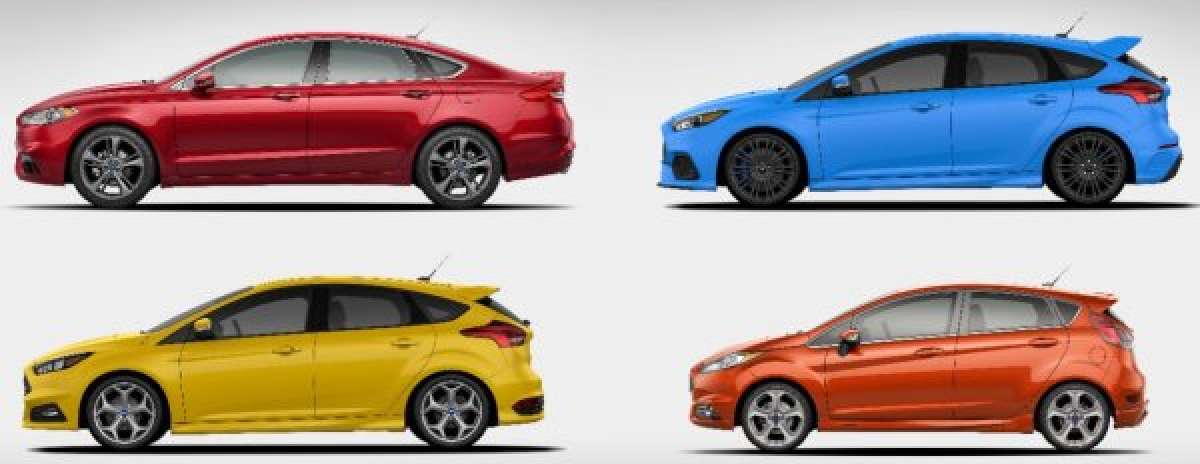While the American market has seen a few popular, high performance compact cars over the past 20 years, the majority of sporty small cars in the past have come from European or Japanese automakers. Ford Motor Company looked to change that by introducing high performance packages for all of their smaller cars and – not surprisingly – these powerful versions of their most popular cars has led to increased sales among younger, wealthier buyers.
“With repeat customers making up around half of industry sales, capturing younger buyers while they still have many vehicle purchases remaining in their lives is good for business,” said Corey Holter, Ford car group marketing manager.
Fiesta ST, Focus ST and RS: America’s Hottest Hatches
For years, the “hot hatch” was a popular component of the sport compact market which was dominated entirely by Japanese and European automakers. Sure, vehicles like the old SVT Focus gave American loyalists a homegrown option for a short time, but Subaru, Mitsubishi, Honda, Volkswagen and Audi have long been the go-to automakers for small high performance cars here in the US market.
That trend began to change when the Ford ST was introduced, followed up by the smaller Fiesta ST a short time later. Once those models were on sale in the US, Ford offered a pair of great hot hatch options for those buyers who wanted something small and affordable, but there were still much hotter hatches on the market.
That all changed when Ford rolled out the new Focus RS, with 350 turbocharged horsepower, a 6-speed manual transmission and all-wheel drive making this American hot hatch one of the quickest and strongest on the market.
Dollar for dollar, the Fiesta ST, the Focus ST and the Focus RS are hard to beat in terms of performance and functionality, and that has led to a greater interest from younger buyers. Basically, the people who have previously bought a European or Japanese hot hatch have turned to Ford for their 5-seater compact performance car needs.
For example, the average age of a non-ST/non-RS Focus buyer is 46 years old, but the average Focus ST buyer is 36 and the average Focus RS buyer is 41. The average non-ST Fiesta buyer is 45, but the average Fiesta ST buyer is 35. Of course, this means that there are people above and below those average ages who buy these vehicles, but the lowered average is a good sign that the ST and RS models are drawing younger buyers to Ford’s bestselling cars.
Along the same lines, the average non-performance Fiesta buyer comes from a household with a total annual income of $59,000 while Fiesta ST households make over $102,000. The average Focus household makes just $63,000, but the Focus ST household makes $108,000 and the Focus RS household makes $169,000. This means that the people buying the Fiesta ST, Focus ST and Focus RS could afford to buy more expensive cars, but they are obviously being drawn in by the performance capabilities of these sporty compact models.
Fusion Sport Shines
Finally, while the new Ford Fusion Sport doesn’t have the same high performance aim as the Fiesta ST or Focus ST/RS, this twin turbocharged V6 package goes a long way in making the Fusion a ton more fun to drive. The Fusion Sport is the quickest of the midsized Ford sedans and while it offers slightly less power than the Taurus SHO, the smaller sedan with the 2.7L EcoBoost makes the Fusion a bit more fun to drive than the SHO.
This new Fusion Sport has had a similar attraction to younger buyers as the Fiesta and Focus performance models, but with the average age of a non-Sport Fusion buyer being 48 years old, the average age of a Fusion Sport buyer is 45 years old – so while the shift is a smaller one, it is an important one.
In the grand scheme of things, Ford doesn’t break out the individual sales numbers for the Fiesta ST, Focus ST, Focus RS and Fusion Sport because they wouldn’t look good relative to the rest of their segment. However, models like these ones aren’t about big sales numbers – they are about bringing in new, younger buyers to the brand. That plan is working well.





